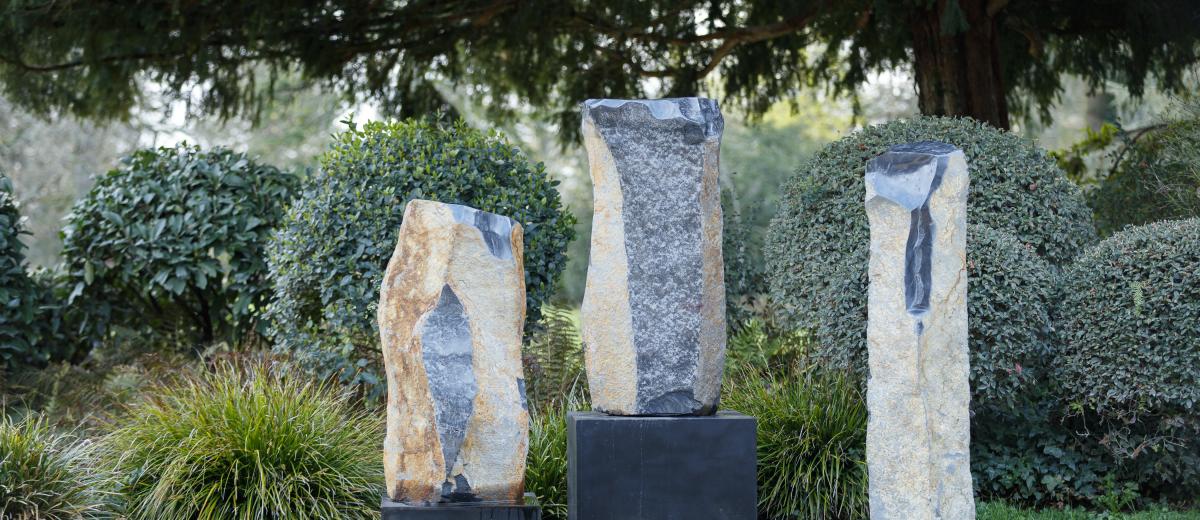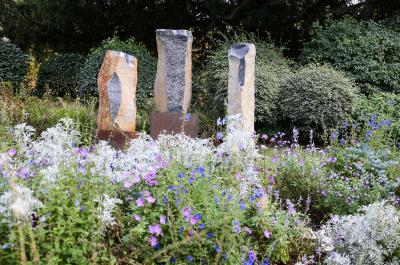Denis Monfleur

Stone wasn’t always been so hard. There was sandstone, then marble. But the initial yearning finally prevailed as granite has nothing decorative about it and implies unmatched physical engagement. It was the very notions of difficulty and differences that lay behind his choice. Denis Monfleur is not a sculptor who uses the kind of materials that create works all on their own. With him, beauty is hard won and comes from within. He’s one of those who take up a hammer to force the stone to express itself after close, no-hold-barred combat with the material. His sculptures arise from the earth, incorruptible for all eternity.
Bathed in light, whipped by the wind, drenched by the rain, they become nothing more than what they are: elements of nature. They come from it and return to it in a cycle of transformation in which the demiurge sculptor’s hand takes possession of impressive volumes of stone to coax totemic forms and half-human creatures from them, poignant and raw. To do so, Denis Monfleur works on monumental volumes weighing several tonnes. Form is born of repeated subtractions. The hand is not in direct contact with the stone, but guides the metal that strikes in order to release the subject within. His works speak of humankind, time and strength. “When Denis Monfleur carves his heads and characters out of basalt, he expresses the vision that he has of humanity. He speaks of contradictions, violence and poetry, egoism and bursts of generosity, blameless and shameful passions – everything that can be rendered by the stone’s nuances of colour, shadow and light, clefts and peaks, smoothness and roughness, elegance of curves and tension of edges,” the art critic Olivier Cena asserted for Télérama.
As a young man, Denis Monfleur opted for working with stone and direct carving, which makes each sculpture a challenge. “There’s no possible way of going back,” he likes to remember, an artist who tirelessly depicts humankind at its most universal. Not forgetting, however, to occasionally make way for “portraiture” in order to acknowledge and pay tribute to the individuals who have marked our history, such as Charles De Gaulle, Marguerite de Navarre, Franz Kafka and Georges Clemenceau. As his urge to carve ever larger blocks of stone increased, the techniques employed evolved, opening up new possibilities. It would take several years before his use of granite became systematic, with polychrome enamelling making its appearance in the meantime. Denis Monfleur plays with the stone’s clefts and reliefs, creates edges and sometimes polishes its surface. Wrapped in concentration, he acts as if guided by the material’s telluric currents.
The sculptor works in the open air, sometimes in the quarries themselves, measuring himself against granite, diorite, lava and basalt. Over time, lines have lost their gentleness and features have hardened under the effect of mechanical tools. From stone that has been carved up, scored, tinted and sanded, emerge angular-featured colossi and their smaller doubles. “In sculpture, you can decide whether or not scale is essential, and be able to create everything from miniature to monumental. As I see it, this aspect of scale is very important, all the more so when it comes to direct carving, where you have to reduce the initial element,” the artist explained to France 3 in 2019. Whatever the case, all his art consists of eliciting the stone’s expression, channelling it without ever stifling it.
Confronted with Denis Monfleur’s monumental sculptures, visitors draw themselves up, faces to the sky. If they invariably evoke times long past and such mythic lands as Egypt and Mesopotamia, if they conjure up images of standing stones or Easter Island’s moai, it’s because they call upon immemorial knowledge, our sense of the sacred, our ability to recognise the power of life, which imbues all beings, even those made of stone.
Three of the artist’s basalt pillar sculptures are on exhibition at Chaumont-sur-Loire.
BIOGRAPHICAL NOTES

Denis Monfleur is a French sculptor. He was born in Périgueux in 1962 and spent his childhood in Paris and then in Nogent-sur-Marne. He started modelling when he was a teenager and got a job with the Paris press at the age of 18 before deciding to devote himself to sculpture fulltime. A self-taught artist, the young man gave up creating in clay in favour of wood and marble, obtaining a place where he could create thanks to the Mayor of Fontenay-sous-Bois’ support. The town held his first exhibition in 1986 and three years later, the Catalan sculptor José Subirà-Puig (1925-2015) hired him as his assistant. Denis Monfleur also went on to collaborate with Dietrich-Mohr (1924-2016) and Marcel Van Thienen (1922-1998). A trio of well-known artists who left their mark on his development.
He was selected for the Fénéon Prize in 1995 but was injured while transporting his piece to the venue. His convalescence provided an opportunity for thought that immediately decided him to start using granite, a stone with particular resistance to bad weather and pollution. Since then, his work has essentially been characterised by direct carving on hard and often monumental blocks of stone. An extremely physical technique that involves decisive actions by which the artist removes parts of the material he is working on. As regards themes, human aspects are central to the sculptor’s concerns.
Since the late 1990s, he has been represented by a series of galleries, starting with the Guigon gallery (1999), followed by the Suzanne Tarasiève gallery (2002), with exhibitions becoming ever more frequent. In 2010, he joined the Claude Bernard gallery. He discovers and develops new techniques, making use of colour and working with increasingly harder types of stone. In 2014, he travelled to Uruguay where he created El Atlante Del Cerro, a monumental, 3-metre-high granite sculpture, along with some thirty others of more modest dimensions (between 25-30 cm).
Various series in the same format followed, also created by direct carving, including Menines and Assis. For the Individus exhibition, held at the Claude Bernard gallery in 2015, the artist presented almost 300 characters sculpted from Mont-Dore lava and seemingly in motion. Busy with unspecified tasks, they carry, lift and take hold of objects that are sometime reminiscent of tables and sometimes of ladders or beams, all painted in orange. An imaginary factory in full swing, the installation has been presented a dozen times, always with new actors added.
In 2016, Denis Monfleur created L’Apporteur de l’espoir. Born of a block of Chambois lava, the sculpture pays tribute to the International Brigades who set off to combat fascism in Spain in 1936. This impressive piece, whose name is a reference to André Malraux’s novel L’Espoir (1937), now stands in front of Gare d’Austerlitz railway station. In 2019, he started to employ a new practice, adding shards of stone and so creating the Rocailles series. Particularly spectacular, his sculpture Masque Koré (wooden core, diorite rocks, hair and plastic) was worn in 2020 by the dancer and choreographer Anne-Sophie Lancelin for one of her creations. Last year, Place Vendôme in Paris was adorned with unaccustomed showpieces: four monumental granite heads of raw, majestic beauty.
Denis Monfleur is represented by Galery Claude Bernard (Paris).


